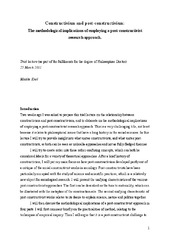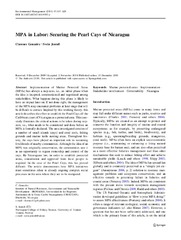Artikler, rapporter og annet (Norges fiskerihøgskole): Recent submissions
Now showing items 1021-1040 of 1061
-
Histological and bacteriological changes in intestine of beluga (Huso huso) following ex vivo exposure to bacterial strains
(Journal article; Tidsskriftartikkel; Peer reviewed, 2011)In the present study the intestinal sac method (ex vivo) was used to evaluate the interactions between lactic acid bacteria and staphylococci in the gastrointestinal (GI) tract of beluga (Huso huso). The distal intestine (DI) of beluga was exposed ex vivo to Staphylococcus aureus, Leuconostoc mesenteroides and Lactobacillus plantarum. Histological changes following bacterial exposure were assessed ... -
Constructivism and post-constructivism : the methodological implications of employing a post-constructivist research approach
(Lecture; Forelesning; Peer reviewed, 2011-03-25) -
MPA in Labor: Securing the Pearl Cays of Nicaragua
(Journal article; Tidsskriftartikkel; Peer reviewed, 2011)Implementation of Marine Protected Areas (MPAs) has always a step-zero, i.e., an initial phase when the idea is incepted, communicated and negotiated among stakeholders. What happens during this phase is likely to have an impact later on. If not done right, the management of the MPA may encounter problems at later stage that will be difficult to correct. Inspired by this working theory, this article ... -
IPNV with high and low virulence: host immune responses and viral mutations during infection
(Journal article; Tidsskriftartikkel; Peer reviewed, 2011)Infectious pancreatic necrosis virus (IPNV) is an aquatic member of the Birnaviridae family that causes widespread disease in salmonids. IPNV is represented by multiple strains with markedly different virulence. Comparison of isolates reveals hyper variable regions (HVR), which are presumably associated with pathogenicity. However little is known about the rates and modes of sequence divergence and ... -
Mapping uncertainties in the upstream : the case of PLGA Nanoparticles in Salmon Vaccines.
(Journal article; Tidsskriftartikkel; Peer reviewed, 2011)The diversity of nanotechnologies and of the governance challenges that their applications raise calls for exploration and learning across different cases. We present an Upstream Oversight Assessment (UOA) of expected benefits and potential harms of nanoparticles made of a synthetic polymer (PLGA) to improve vaccines for farmed salmon. Suggested by Jennifer Kuzma and colleagues, an UOA may help ... -
Seasonal variability of meio- and macrobenthic standing stocks and diversity in an Arctic fjord (Adventfjorden, Spitsbergen)
(Journal article; Tidsskriftartikkel; Peer reviewed, 2011)Strong environmental seasonality is a basic feature of the Arctic system, still there are few published records of the seasonal variability of the Arctic marine biota. This study examined the year-round seasonal changes of soft bottom macro- and meiobenthic standing stocks and diversity on a station located in an Arctic fjord (Adventfjorden, Spitsbergen). The seasonality observed in benthic biota ... -
Transcription of reference genes used for quantitative RT-PCR in Atlantic salmon is affected by viral infection
(Journal article; Tidsskriftartikkel; Peer reviewed, 2011)Relative quantification using RT-qPCR is a widely used method for transcription profiling. Transcript levels of target genes in fish after experimental infection is often reported without documentation of stably transcribed reference genes. We present results demonstrating that transcription of typically used reference genes in Atlantic salmon is not stable during experimental infection with salmon ... -
Dynamics of bacterial community exposed to hydrocarbons and oleophilic fertilizer in high-Arctic intertidal beach
(Journal article; Tidsskriftartikkel; Peer reviewed, 2011)Exposure of pristine microbial environments to hydrocarbon contamination stimulates growth of the initially small fraction of indigenous hydrocarbon-degrading bacteria. Custom-made oleophilic fertilizers have been demonstrated to promote oil bioremediation by boosting this proliferation. In the present study, the temporal dynamics of the bacterial community structure and the individual influences ... -
Evaluation of probiotic strain Bacillus subtilis C-3102 as a feed supplement for koi carp (Cyprinus carpio)
(Journal article; Tidsskriftartikkel; Peer reviewed, 2011)In this study, the effects of dietary probiotic Bacillus subtilis C-3102 (Calsporin®) on the growth performance, predominant intestinal microbiota, expression of cytokines genes in three organs (liver, intestine and kidney) and protection against Aeromonas hydrophila infection of koi carp were investigated. Fish were fed two different diets, 1-control diet (non-supplemented) and 2-experimental diet ... -
Evaluation of prebiotic and probiotic effects on the intestinal gut microbiota and histology of Atlantic salmon (Salmo salar L.)
(Journal article; Tidsskriftartikkel; Peer reviewed, 2011)In the present study the impact on gut microbiology and indigenous gut histology of Atlantic salmon (Salmo salar L.) was investigated following feeding of a control and a prebiotic (EWOS prebiosal®) diet and ex vivo exposure to saline or the probiotic bacterium Carnobacterium divergens. The results showed that ex vivo exposure of C. divergens at 108 CFU ml-1 did not cause cell damage to the intestine ... -
Do stocking densities affect the gut microbiota of gibel carp (Carassius auratus gibelio) cultured in ponds?
(Journal article; Tidsskriftartikkel; Peer reviewed, 2011)The aim of the present study was to evaluate the intestinal microbial communities of gibel carp (Carassius auratus gibelio) cultivated in two beach ponds at different stocking densities. The two ponds were both ~3.33 hm2 in acreage and ~1.5 m in depth. The stocking densities included one intensive with 2 fish m–3 while the other treated as semi-intensive with 1 fish m–3. The gut microbiota (both ... -
The ecological and economic value of cold-water coral ecosystems
(Journal article; Tidsskriftartikkel, 2010)Despite the growing scientific literature on cold-water corals (CWC) there appears to be no studies that address the economic values or economic management of the resource. This paper presents an overview of the goods and services of CWC and their associated biodiversity. Use and non-use values associated with CWC are presented, and the methods relevant for assessing their valuation are discussed. ... -
The evolution of the “harvest machinery” : why capture capacity has continued to expand in Norwegian fisheries
(Journal article; Tidsskriftartikkel; Peer reviewed, 2005)Controlling the expansion of capture capacity has been a major challenge for the fisheries management systems around the North Atlantic. Despite focused attempts to reduce this capacity in recent years in different jurisdictions, it has continued to expand. This chapter uses a case study of changes in Norwegian fisheries to help explain why this has happened. The article supports the replacement of ... -
A bioeconomic MPA study based on cellular automata population growth and distribution
(Journal article; Tidsskriftartikkel; Peer reviewed, 2011)This paper investigates possible biological and economic effects of using marine sanctuaries as a management tool, employing cellular automata techniques to model biological growth and area distribution, assuming open access to the fish stock resources outside the protected area. The cellular automata model incorporates a fish harvest model based on standard assumptions. In agreement with previous ... -
Latour, natur,og havforskere : hvordan produsere natur?
(Journal article; Tidsskriftartikkel; Peer reviewed, 2004) -
Protected areas for conflict resolution and management of recreational and commercial fisheries
(Journal article; Tidsskriftartikkel; Peer reviewed, 2010) -
Dietary enrichment of apolipoprotein E-deficient mice with extra virgin olive oil in combination with seal oil inhibits atherogenesis
(Journal article; Tidsskriftartikkel; Peer reviewed, 2011) -
MPA in Labour: Securing the Pearl Cays of Nicaragua
(Journal article; Tidsskriftartikkel; Peer reviewed, 2010) -
Analysis of bacterial diversity in the intestine of grass carp (Ctenopharyngodon idellus) based on 16S rDNA gene sequences
(Journal article; Tidsskriftartikkel; Peer reviewed, 2010) -
The Nornir run-time system for parallel programs using Kahn process networks on multi-core machines – A flexible alternative to MapReduce
(Journal article; Tidsskriftartikkel; Peer reviewed, 2010)


 English
English norsk
norsk


















